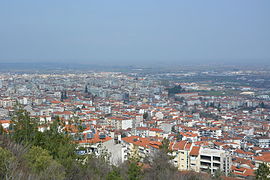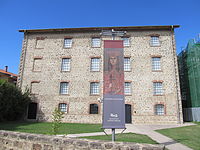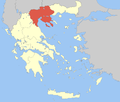Veria
Veria
Βέροια | |
|---|---|
 Panoramic view | |
|
UTC+3 (EEST) | |
| Postal code | 591 31, 591 32 |
| Area code(s) | 2331 |
| Vehicle registration | ΗΜ |
| Website | www.veria.gr |
| Official name | Archaeological Site of Aigai (modern name Vergina) |
| Includes |
|
| Criteria | Cultural: (i)(iii) |
| Reference | 780 |
| Inscription | 1996 (20th Session) |
| Area | 1,420.81 ha (3,510.9 acres) |
| Buffer zone | 4,811.73 ha (11,890.0 acres) |

Veria (Greek: Βέροια or Βέρροια, romanized: Véroia or Vérroia; Aromanian: Veria[2]), officially transliterated Veroia, historically also spelled Beroea or Berea,[3] is a city in Central Macedonia, in the geographic region of Macedonia, northern Greece, capital of the regional unit of Imathia. It is located 511 kilometres (318 miles) north-northwest of the capital Athens and 73 km (45 mi) west-southwest of Thessaloniki.
Even by the standards of Greece, Veria is an old city; first mentioned in the writings of
The extensive archaeological site of
History
Classical and Roman Veria

The city is reputed to have been named by its
Veria surrendered to
As soon as it was night, the brothers sent Paul and Silas away to Berea. On arriving there, they went to the Jewish synagogue. Now the Bereans were of more noble character than the Thessalonians, for they received the message with great eagerness and examined the Scriptures every day to see if what Paul said was true. Many of the Jews believed, as did also a number of prominent Greek women and many Greek men. When the Jews in Thessalonica learned that Paul was preaching the word of God at Berea, they went there too, agitating the crowds and stirring them up. The brothers immediately sent Paul to the coast, but Silas and Timothy stayed at Berea. The men who escorted Paul brought him to Athens and then left with instructions for Silas and Timothy to join him as soon as possible.
—Acts17:10–15
Recent Discoveries
In December 2021, archaeologists announced the discovery of an unfinished Roman-era statue of a young athletic man at Agios Patapios. The headless marble statue is about three feet tall. According to the Greece's Culture Ministry, the sculpture has similarities to statues of the Greek gods Apollo and Hermes.[7][8][9]
Byzantine Veria



Under the

In the 7th century, the
The city was apparently held by the
After the
The 14th century was tumultuous: the area was pillaged by
According to a tradition preserved by
Ottoman Veria

The Ottomans called Veria Karaferye ("black Veria"), because of its characteristic morning mist during the humid winter seasons.[14][13] In 1519 (Hijri 925) the town had 231 Muslim and 578 Christian households.[15] Under Ottoman rule, Veria was the seat of a kaza within the Sanjak of Salonica; by 1885, the kaza, along with Naoussa, included 46 villages and chiftliks.[13] The 17th-century traveller Evliya Çelebi reports that the city was peaceful, without walls or garrison; it had 4000 houses, 16 Muslim quarters, 15 Christian quarters, and 2 Jewish congregations. The city was a prosperous center of rice production.[13]
According to the 1881/82-1893 Ottoman General Census, the kaza of Veria (Karaferiye) had a total population of 25,034, consisting of 15,103 Greeks, 7,325 Muslims, 2,174 Bulgarians, 393 Jews, and 39 foreign citizens.[16] Veria was an important regional center of Greek commerce and learning, and counted many important Greek scholars as its natives (e.g. Ioannis Kottounios)

Modern Veria
The presence of a large, prosperous and educated bourgeoisie made Veria one of the centers of Greek nationalism in the region of Macedonia, and the city's inhabitants had an active part in the Greek War of Independence; important military leaders during the uprising included Athanasios Syropoulos, Georgios Syropoulos, Dimitrios Kolemis and Georgios Kolemis, among others;[17] however, as was the case with the rest of Northern Greece, eventually the uprising was defeated, and Veria only became part of modern Greece in 1912 during the Balkan Wars, when it was taken by the Hellenic Army on October 16, 1912 (October 16 is an official holiday in Veria, commemorating the city's incorporation to Greece), and was officially annexed to Greece following the signing of the Treaty of Athens in November 1913.[13]

World War II
During
During the Occupation almost all of the Jewish community of the city was deported and exterminated by the Nazis.[18]

Postwar
Postwar Veria saw a significant rise in population, and a greatly improved standard of living. The 1980s and 1990s in particular were a period of prosperity, with the agricultural businesses and cooperatives in the fertile plains around Veria successfully exporting their products in Europe, the US and Asia. The discovery of the tomb of
Veria has a significant immigrant population, mainly from countries of Central and Eastern Europe.
Ecclesiastical history
Berrhoea was a
The names of five of its bishops appear in extant contemporary documents:
- Gerontius took part in the Council of Sardica(c. 344),
- Lucas in the Robber Council of Ephesus(449),
- Sebastian in the Council of Chalcedon (451),
- Timothy in Patriarch Menas of Constantinoplein 536, and
- Joseph in the
The Byzantine emperor
Latin titular see
The diocese of Berrhoea was nominally restored in 1933 by the
It has been vacant for decades, having the following incumbents:
- Cardinal Alfredo Ottaviani (Italian) (1962.04.05 – 1962.04.20)
- Pierre-Auguste–Marie–Joseph Douillard (1963.05.22 – 1963.08.20) as emeritate
- Federico Kaiser Depel, M.S.C.(1963.10.29 – death 1993.09.26)
Local government — municipality
The municipality Veria was formed at the 2011 local government reform by the merger of the following 5 former municipalities, that became municipal units:[22]
The municipality has an area of 796.494 km2, the municipal unit 359.146 km2.[23]
Geography

Geology
Veria is located at 40º31' North, 22º12' East, at the eastern foot of the
Climate
This section includes a improve this section by introducing more precise citations. (February 2021) ) |
Veria has a humid subtropical climate (
| Climate data for Veria | |||||||||||||
|---|---|---|---|---|---|---|---|---|---|---|---|---|---|
| Month | Jan | Feb | Mar | Apr | May | Jun | Jul | Aug | Sep | Oct | Nov | Dec | Year |
| Record high °C (°F) | 21.0 (69.8) |
24.0 (75.2) |
25.4 (77.7) |
31.0 (87.8) |
35.0 (95.0) |
39.0 (102.2) |
41.0 (105.8) |
42.1 (107.8) |
35.9 (96.6) |
33.5 (92.3) |
27.0 (80.6) |
25.6 (78.1) |
42.1 (107.8) |
| Mean daily maximum °C (°F) | 9.1 (48.4) |
10.8 (51.4) |
14.5 (58.1) |
19.4 (66.9) |
25.1 (77.2) |
29.5 (85.1) |
31.3 (88.3) |
30.9 (87.6) |
27.8 (82.0) |
21.6 (70.9) |
14.3 (57.7) |
10.1 (50.2) |
20.4 (68.7) |
| Daily mean °C (°F) | 4.6 (40.3) |
5.9 (42.6) |
9.4 (48.9) |
14.1 (57.4) |
19.6 (67.3) |
24.1 (75.4) |
25.7 (78.3) |
24.7 (76.5) |
21.1 (70.0) |
15.6 (60.1) |
9.5 (49.1) |
5.7 (42.3) |
15.0 (59.0) |
| Mean daily minimum °C (°F) | 0.6 (33.1) |
1.4 (34.5) |
4.4 (39.9) |
8.2 (46.8) |
12.8 (55.0) |
16.3 (61.3) |
18.0 (64.4) |
17.3 (63.1) |
14.1 (57.4) |
9.9 (49.8) |
5.3 (41.5) |
1.8 (35.2) |
9.2 (48.6) |
| Record low °C (°F) | −12.0 (10.4) |
−11.0 (12.2) |
−4.0 (24.8) |
4.0 (39.2) |
7.7 (45.9) |
14.6 (58.3) |
14.3 (57.7) |
13.5 (56.3) |
7.1 (44.8) |
1.1 (34.0) |
−3 (27) |
−5 (23) |
−12.0 (10.4) |
| Average precipitation mm (inches) | 44.5 (1.75) |
49.0 (1.93) |
56.4 (2.22) |
45.0 (1.77) |
42.0 (1.65) |
29.7 (1.17) |
14.1 (0.56) |
16.2 (0.64) |
16.1 (0.63) |
55.7 (2.19) |
68.1 (2.68) |
69.1 (2.72) |
505.9 (19.91) |
| Average precipitation days | 8.2 | 9.1 | 9.5 | 8.6 | 8.6 | 5.1 | 3.9 | 3.5 | 3.6 | 7.5 | 9.9 | 9.2 | 86.7 |
| Average relative humidity (%)
|
76.4 | 73.0 | 73.2 | 68.3 | 64.2 | 57.9 | 57.5 | 62.8 | 66.8 | 73.1 | 77.1 | 78.2 | 69.0 |
| Mean monthly sunshine hours | 117.1 | 120.4 | 143.8 | 190.4 | 234.9 | 295.3 | 309.6 | 290.6 | 224.9 | 162.1 | 118.3 | 109.1 | 2,316.5 |
| Source: Hellenic National Meteorological Service, National Observatory of Athens | |||||||||||||
Economy

The modern town has cotton and woolen mills and trades in wheat, fruit and vegetables. Lignite mines operate in the area. The largest wind farm in Greece is to be constructed in the Vermio Mountains by Acciona, S.A. It will consist of 174 wind turbines, which will be connected to the national electric power transmission network, generating 614 MW.
Transport
Road
Veria is connected to the motorway system of Greece and Europe through Egnatia Odos, the Greek part of the European route E90. It is also connected to more than 500 local and national destinations via the national coach network (KTEL).
Rail
Air
Culture

The city has a number of Byzantine monuments, as well as post-Byzantine churches built on Byzantine foundations.
Museums in Veria include the
There is also a 19th-century Jewish synagogue in the protected former Jewish neighbourhood in Barbuta.The archaeological site of Aegae/Aigai (Αἰγαί; modern name
Every summer (August 15 to September 15) the "Imathiotika" festivities take place with a cultural program deriving mainly from Veria's tradition. The site of Elia has an extensive view of the Imathia plain. Neighboring
Education
Veria has one of the largest public libraries in Greece. Originally a small single-room library with limited funds and material, it expanded into a four-story building offering multimedia, and special and rare editions. Veria's public library collaborates with many international organizations and hosts several cultural events. In 2010, it won the Access to Learning Award (ATLA) prize nominated by the Bill & Melinda Gates Foundation and the amount of $1.000.000. Since then, the library became a role model for other libraries in Greece.[26]
The Department of
Twin towns — sister cities
Veria is
 Strovolos, Cyprus (1993)[28]
Strovolos, Cyprus (1993)[28] Kazanlak, Bulgaria
Kazanlak, Bulgaria Rognac, France[28]
Rognac, France[28] Užice, Serbia
Užice, Serbia Cava de' Tirreni, Italy (2024)
Cava de' Tirreni, Italy (2024)
Sports
Veria is home to many sports clubs. Most prominent is the handball team of Filippos Veria, competing in the first national division and which has won many championships (both national and international) over the last 40 years. The most famous is
| Sport clubs based in Veria | |||
|---|---|---|---|
| Club | Founded | Sports | Achievements |
| Veria F.C. | 1960 | Football | Presence in A Ethniki (First division) |
| Filippos Verias | 1962 | Handball, Basketball | Panhellenic titles in Greek Handball, one of the most successful Handball teams in Greece |
GE Veria |
Handball | Panhellenic titles in Greek Handball | |
Pontioi Verias F.C. |
1984 | Football | Earlier presence in Beta Ethniki |
| AOK Veria | 1998 | Basketball | Earlier presence in A2 Ethniki women |
Notable locals

- Sopater, kinsman of Saint Paul
- Demetrius Vikelas, Greek writer; the first president of the International Olympic Committee (IOC)
- Konstantinos Raktivan, liberal politician, lawyer, Greek Council of State's first president, member of the Academy of Athens, speaker of the Hellenic Parliament
- Ioannes Kottounios, Renaissance humanist and philosopher
- Kallinikos Manios, scholar
- Konstantinos Kallokratos, teacher and poet
- Patriarch Metrophanes of Alexandria, Patriarch of Alexandria
- Patriarch Nephon I of Constantinople, Ecumenical Patriarch (Constantinople)
- Sonia Theodoridou, Greek soprano
- Efthymios Varlamis, Greek architect, sculptor and painter
- Sedat Alp, Turkish archaeologist
- Michalis Chrysochoidis, Greek politician
- Yorgos Karamihos, Greek actor
- Mimis Papaioannou, Greek football player
- Kostas Tsartsaris, Greek professional basketball player
- Yiannis Arabatzis, footballer
- Pantelis Kafes, footballer
- Panagiotis Tsalouchidis, former football player
- Pavlos Kontogiannidis, actor, singer
- Dimitris Mavropoulos, actor and theatrical director
- Macedonian struggle, publicist against the Hellenization of Aromanians(Vlachs) in Macedonia
- George Murnu, Romanian university professor, archaeologist, historian, translator, and poet
- Elie Carafoli, Romanian engineer and aircraft designer
- Ion Caranica, Romanian, activist of Iron Guard death squads
- Sterie Ciumetti, Romanian, activist of Iron Guard
- Kyriakos Amiridis, Greek diplomat
- Konstadinos Stefanopoulos, Olympic race walker
- Sofia Ifantidou, Olympic record holder in heptathlon javelin throw
- Maria Ntanou, Olympic cross country skier
Gallery
-
Altar ofSaint Paul
-
Statue of St Paul
-
The Byzantine Church of the Resurrection
-
Dormition fresco (1315) by Georgios Kalliergis in the Church of the Resurrection
-
View of Barabuta, Jewish quarter
-
Sts Kiriqos and Ioulitta Byzantine church (14th)
-
Christ fresco by Georgios Kalliergis (1315) in the Church of the Resurrection
-
Fresco in the Old Metropolis (14th)
-
Saint Antonios church (19th)
-
Traditional dress
-
Aerial view of the city during dusk
See also
- List of settlements in Imathia
- List of Catholic dioceses in Greece
- Bereans, various Protestant sects named after the city
- Murder of Alex Meschisvili
References
- ^ "Αποτελέσματα Απογραφής Πληθυσμού - Κατοικιών 2021, Μόνιμος Πληθυσμός κατά οικισμό" [Results of the 2021 Population - Housing Census, Permanent population by settlement] (in Greek). Hellenic Statistical Authority. 29 March 2024.
- ^ Sterghiu, Hristu (10 January 2012). "Agenda aromână Retrospectiva 2011 II – 12.ian.10" (in Aromanian). Radio Romania International.
- ^
 Smith, William, ed. (1854–1857). "Berœa". Dictionary of Greek and Roman Geography. London: John Murray.
Smith, William, ed. (1854–1857). "Berœa". Dictionary of Greek and Roman Geography. London: John Murray.
- ^ veria.gr Veria:Its history (greek) Archived March 6, 2008, at the Wayback Machine accessed June 1, 2008.
- ^ Λούκιος ή Όνος 34.15–17
- ^ (greek) hellasportal.gr,Apostle Paul preach in Veria[permanent dead link], accessed June 1, 2008.
- ^ "Unfinished Roman-era statue found in old Macedonian capital Veria". The Jerusalem Post. Retrieved 2022-02-19.
- ^ "Άγαλμα των αυτοκρατορικών χρόνων αποκαλύφθηκε σε σωστική ανασκαφή στο κέντρο της Βέροιας". www.culture.gov.gr. Retrieved 2022-02-19.
- ^ "Unfinished Sculpture Discovered at Agios Patapios – Archaeology Magazine". www.archaeology.org. Retrieved 2022-02-19.
- ^ ISBN 0-19-504652-8.
- ^ Migne, Jacques Paul. Patrologia Graeca, t. 126, col. 529.
- ^ a b c Nicol, Donald MacGillivray (1976). "Refugees, Mixed Population and Local Patriotism in Epiros and Western Macedonia after the Fourth Crusade". XVe Congrès international d'études byzantines (Athènes, 1976), Rapports et corapports I. Athens. pp. 3–33.
{{cite book}}: CS1 maint: location missing publisher (link) - ^ OCLC 758278456.
- ^ History of Veria Municipality of Veria
- ISSN 0041-4255.
- The University of Wisconsin Press, p. 134-135
- ^ Ανέκδοτα έγγραφα και άγνωστα στοιχεία για κλεφταρματολούς και για την επανάσταση (1821–1822) στη Μακεδονία και ιδιαίτερα στον Όλυμπο, Γεώργιος Χ. Χιονίδης, Βέροια 1979[permanent dead link]
- ^ "VEROIA".
- ^ Michel Lequien, Oriens christianus in quatuor Patriarchatus digestus, Paris 1740, Vol. II, coll. 69–74
- ^ Raymond Janin, v. 1. Berrhée in Dictionnaire d'Histoire et de Géographie ecclésiastiques, vol. VIII, 1935, coll. 885–887
- ISBN 978-88-209-9070-1), p. 838
- ^ "ΦΕΚ A 87/2010, Kallikratis reform law text" (in Greek). Government Gazette.
- ^ "Population & housing census 2001 (incl. area and average elevation)" (PDF) (in Greek). National Statistical Service of Greece. Archived from the original (PDF) on 2015-09-21.
- ISSN 1108-2402.
- ^ Λαογραφικό Μουσείο Βλάχων
- ^ "Bill & Melinda Gates Foundation: Access to Learning Award (ATLA)". Bill & Melinda Gates Foundation.
- ^ Athena plan News247.gr
- ^ a b "Twinnings" (PDF). Central Union of Municipalities & Communities of Greece. Retrieved 2013-08-25.
- ISBN 0-313-30813-6.
KOTTOUNIOS, IOANNES (1577–1658) Born at Beroia (Macedonia)
Sources and external links
 Veria travel guide from Wikivoyage
Veria travel guide from Wikivoyage- Veroia Municipality (official website)
- GCatholic
- Bibliography – ecclesiastical history
- Mansi, Sacrorum conciliorum nova et amplissima collection, passim
- Pius Bonifacius Gams, Series episcoporum Ecclesiae Catholicae, Leipzig 1931, p. 429
- Michel Lequien, Oriens christianus in quatuor Patriarchatus digestus, Paris 1740, vol. II, coll. 69–74
- Raymond Janin, lemma '1. Berrhée' in Dictionnaire d'Histoire et de Géographie ecclésiastiques, vol. VIII, 1935, coll. 885–887
- Bibliography – synagogue and jewish history
- Μεσσίνας, Ηλίας. (2022). H Συναγωγή. Αθήνα: Εκδόσεις Ινφογνώμων. ISBN 978-618-5590-21-5
- Messinas, Elias. (2022). The Synagogue of Veroia | Η Συναγωγή της Βέροιας. Seattle: KDP. ISBN 979-884-6836-06-8
- Messinas, Elias. (2022). The Synagogues of Greece: A Study of Synagogues in Macedonia and Thrace: With Architectural Drawings of all Synagogues of Greece. Seattle: KDP. ISBN 979-8-8069-0288-8














